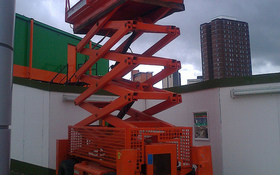Heights Matter When Choosing an Aerial Lift
Aerial lifts help workers reach out-of-the-way storage spots, assist in complicated construction projects, and enable effective painting and repair jobs, among many other uses. If your business has plenty of tasks that occur well above head-level, consider buying an aerial lift to help out around the warehouse or work site. Choosing the right aerial lift height is the key to a good purchase. Here are several of the most popular options.
Basic reach: 6 to 50 feet
Basic reach lifts extend platforms anywhere from 6 to 50 feet vertically, with some flexible limitations based on brand (certain vehicles, for example, may go as high as 60 feet). These are commonly called scissor lifts, for their readily identifiable section of crisscrossing braces that hoist the platform up or down, often using pneumatic pressure.

As with all aerial lifts, the larger the scissor lift, the higher it can generally go. Electric models work well in warehouse or storage situations where companies need to reach products stored on high shelves or perform similar tasks. For outdoor and rough terrain applications, 4-wheel drive models are typically powered by a 35 to 82 HP engine and run on diesel fuel.
Costs range from around $6,000 to $20,000 new for the most common 6- to 20-foot models, and $2,200 to $8,500 for similar scissor lifts in used condition.
Extended reach: 35 to 150 feet
Extended reach lifts are a better fit for outdoor activities where companies need as much lift as possible. Articulating booms are a common option in this category: These booms lift and expand in single sections that slowly rise from a folded position. While they cannot lift as much weight as a scissor lift or support as broad a platform, they offer an ideal solution for hard-to-reach places that are more than just a few stories off the ground.
Available in 2-wheel and 4-wheel configurations, articulated lifts offer models that operate on rough terrain as well as narrow models that enable them to slip in between tight spaces. These are a good choice if companies need to clean high places outdoors or work in outdoor loading and construction sites where there is plenty of upward action.
And as is the case with so much of the industrial machinery on the market today, some articulating booms are available with electric power. This not only enables you to operate them safely indoors but also eliminates the potential for pollutants, making them clean and energy efficient.
Easy to find new or used, costs range from $2,000 to $30,000 used, and $20,000 to $100,000 plus for new machines.
Spot-based reaching: 30 to 80 feet
Certain lifts, such as telescopic booms, do not have the same reach as articulating booms, but offer more flexibility in the most complicated sites. These booms focus on providing maximum reach as well as significant height benefits. They are used in conjunction with other construction and loading equipment when contractors need to reach difficult positions.
Costs can range from $100,000 to $167,000 for new models and $39,000 to $70,000 for used.
Platform considerations
When considering aerial lift heights, take the time to look into the different types of platforms available. Platforms offer extensions for extra room, railings for greater safety, and control panels for in-air adjustments. Pay attention to safety guidelines and choose a platform that meets local requirements while making your lift as efficient as possible.
Ready to Compare Aerial Lifts Price Quotes?